20 Health IT Leaders Who Are Driving Change20 Health IT Leaders Who Are Driving Change
Innovation is tough amid today's regulatory checklists. These leaders are getting it done.

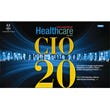
information Healthcare - May 2013

information Green
Download the May 2013 issue of information Healthcare, distributed in an all-digital format (registration required).
A few years ago Atrius Health, a major independent physicians group, tried giving elderly, chronically ill patients devices that they could use in their homes to do things such as provide a verbal reminder to take their medications. "It absolutely made sense," says Dr. Michael Lee, Atrius Health's director of informatics. "It just didn't work." People simply didn't like using the devices, so adoption was tiny. But, Lee says, this is exactly the kind of experimentation health IT leaders need to be doing. "The honest answer is we don't know what changes in processes will truly impact a lot of these patients," he says, "... and the only way we can learn is to innovate and try and see what the outcome is."
Lee, who's also a pediatrician, is among the health IT leaders we recognize in this year's information Healthcare CIO 20. We call it the "CIO" 20, but as Lee's presence shows, we include people holding many titles who are driving change in their organizations and the industry. The list calls out leaders in informatics, in data integration, even the CEO of a health information exchange. This mix reflects the fact that many people are influencing the tech decisions at health organizations. Lee's colleague at Atrius Health, CIO Dan Moriarty, also is on the CIO 20. This year's list is the third annual one, and as in past years, it highlights new leaders.
Today's health IT leaders must balance practical realities with a sense of purpose. They're in healthcare to cure the sick and keep people healthy, and they believe IT can help improve care and lower the costs. But the practical piece is that government regulatory requirements dominate the short-term tech agenda, particularly healthcare providers' need to meet Meaningful Use standards to receive electronic health record subsidies.
These 20 leaders are helping their organizations strike the right balance between these pressures. We see Rady Children's Hospital-San Diego experimenting with the Internet of things -- connecting monitoring devices in new ways for better understanding of patient health. We see groups such as University of Pittsburgh Medical Center, Iowa Health System and Dana-Farber Cancer Institute trying out new ways to apply analytical software. And we see people like Ed Marx, CIO of Texas Health Resources, keeping all this technology grounded in patient needs by insisting that his IT leadership team, himself included, spend time on rounds with clinical staff.
As Michael Smith, CIO of Lee Memorial Health System, puts it, "There is more to do than there is funding or time to do it." Health IT requires tough choices, and these 20 leaders are helping their organizations get those choices right.
-- Chris Murphy
Get the full list and articles here in our free digital issue PDF,
or click through below to read the profiles.
Albert Oriol
CIO, Rady Children's Hospital - San Diego
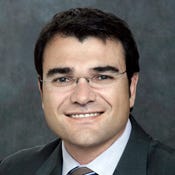
Albert Oriol
Albert Oriol CIO, Rady Children's Hospital - San DiegoThe 475-bed Rady Children's Hospital-San Diego, the largest pediatric hospital in California, is trying to bring device data directly into electronic records. It's including not only clinician documentation in its Epic Systems electronic health records, it's also integrating medical device data with the help of the Vectored Event Grid Architecture platform from Nuvon.
That system lets it pull data from monitors of vital signs at every bed in the hospital, and anesthesia devices talk directly to the Epic anesthesia module, saving anesthesiologists time recording data in the EHR. "They're actually very happy with that," CIO Albert Oriol says. Rady brought this system online at the same time it went live with electronic anesthesia documentation.
The hospital also is experimenting with drawing data from home-based devices, including glucometers, heart monitors and asthma inhalers. That project is a proof of concept for the institutional review board. Clinicians have to go to a website to see the data, but eventually this will be directly integrated with the EHR.
"We're doing this now without [direct] integration per se because we want to prove that the integration works before we invest in it," Oriol says. "This could be an avalanche of data for our clinicians." Oriol is convinced that "we will be able to take better care of the patient if we can monitor their health on an ongoing basis," Oriol says.
Oriol faces less stringent Meaningful Use compliance pressures than many on this list. Children's hospitals and pediatricians don't see Medicare patients, so they're only eligible for the Medicaid side of federal health IT incentives. That means fewer requirements and more room to experiment. "We approached MU with a different mindset," Oriol says.
-- Neil Versel
Cris Ross
CIO, Mayo Clinic
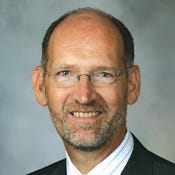
Cris Ross
Cris Ross CIO, Mayo ClinicMayo Clinic cares for nearly 2 million patients a year from nearly 150 countries, and Mayo's reputation results in its specialists seeing more complex and unusual cases than typical physicians do. CIO Cris Ross's IT team is trying to find ways to share the resulting expertise by providing tools to physicians within Mayo and with affiliated practices.
For example, Mayo has established an online service called AskMayoExpert (AME). The program provides clinicians with snapshots of specific cases and offers what Mayo considers the best treatments. AME also gives its physicians direct access to Mayo experts, says Ross, who joined Mayo in August 2012.
Not satisfied with that outreach initiative, Mayo's board of directors recently outlined one of its most ambitious undertakings yet. By 2020, it wants to expand its reach from nearly 2 million patient contacts a year to 200 million. Since that can't happen through in-person patient visits alone, the clinic is using telemedicine initiatives and other online services to help reach that lofty goal.
-- Paul Cerrato
Rasu Shrestha
VP, University of Pittsburgh Medical Center
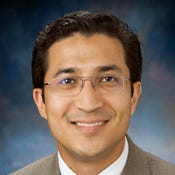
Rasu Shrestha
Rasu Shrestha VP, University of Pittsburgh Medical CenterRasu Shrestha is pushing the University of Pittsburgh Medical Center to get away from looking at patients' data as silos that are "application-centric or chart-centric," he says. What's needed is to integrate all the disparate data streams --from electronic records, lab services systems and medical imaging systems, for example. That sounds simple, he says, but it's really a "complex game of connecting the dots."
Shrestha, as VP of medical IT and medical director of interoperability and imaging informatics, is responsible for helping UPMC make better use of its data. UPMC is a $10 billion-a-year integrated health insurer and healthcare provider, operating more than 20 hospitals and serving nearly 1.6 million members. With roots in academic research, it's among the leaders in using IT to help healthcare move away from a fee-for-services to a pay-for-performance model.
UPMC initially put its resources into creating a technology foundation, including widespread conversion from paper to digital medical records and from film-based medical imaging to filmless technology. Phase two now focuses on using electronic health records and digital imaging to drive this more patient-centric system that delivers better care at the bedside.
From a technological standpoint, this journey has meant semantically harmonizing long lists of the medical jargon clinicians use and mapping it to the nationally accepted dictionaries of medical terms that are coded into most software, such as SNOMED, LOINC and RxNorm.
How does that translate to better care at the bedside? When Ms. Jones comes into a UPMC emergency room with a heart attack, clinicians will use the emergency room's electronic medical record system from Cerner to enter her condition and medications. More importantly, if the patient was previously given nitroglycerin in one of UPMC's ambulatory care facilities, which use Epic EMR software, the doctors in the ER can read that medication note and understand its relevance to the patient's current myocardial infarction, despite it being in an EMR from a different vendor. "We are able to map that medication to any one of our other EMRs throughout the health system, the health information exchange, and to the data warehouse on the back end, including on the payer side," says Shrestha.
While health systems struggle with health information exchange within their walls and across the nation, UPMC has made strides in both areas. But its crowning achievement to date, led by Shrestha and his team, has been establishing fully integrated, enterprise-wide interoperability. Because of that, UPMC is ready to feed its enterprise analytics efforts with data coming in from clinical, financial, research and operational streams.
-- Paul Cerrato
Joy Grosser
VP & CIO, Iowa Health System
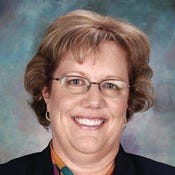
Joy Grosser
Joy Grosser VP & CIO, Iowa Health SystemUnder CIO Joy Grosser, the seven-hospital Iowa Health System is close to completing a nearly four-year transition from a fragmented inpatient electronic health record system. It's replacing a system in which nurses did most order entry, with ambulatory care records on a different platform, to an integrated enterprise EHR. This year, Iowa Health will apply for HIMSS Analytics recognition of its system as a Stage 7 EHR, the highest level. The key to Iowa Health's turnaround has been its openness to change "from top to bottom," Grosser says, "because we really believe we're changing healthcare for the future."
Iowa Health already has as an accountable care organization, which contracts with Medicare and private payers for the care of more than 100,000 patients. So it's crucial for the organization to harness IT to improve care coordination and do population health management.
But it's not the IT department driving initiatives, Grosser says. Iowa Health consistently seeks feedback from its doctors, nurses and administrators looking for how IT can support the organization. In fact, Grosser is the only IT representative on the system's 20-member IT governing council.
"We want our strategic plan to be enabled by IT and information, but not to have compromises to that strategic plan made by IT," Grosser says. "We want to drive side by side with the providers."
Grosser comes out of hospital operations, and despite having spent more than 20 years in health IT at various institutions, she has never forgotten her experience in operations. "You have to think about the need for information on the planning side: What are we trying to accomplish?" she says. "Strategic planning and IT planning go hand in hand and have always been part of my mantra."
-- Ken Terry
Jeffrey Kessler
CIO, Dana-Farber Cancer Institute
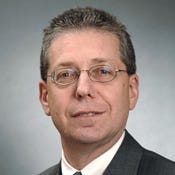
Jeffrey Kessler
Jeffrey Kessler CIO, Dana-Farber Cancer InstituteBoston's Dana-Farber Cancer Institute has three major missions: providing care for cancer patients, developing new cancer treatments and training oncologists. CIO Jeffrey Kessler and his IT department support all of those missions.
On the research side, Dana-Farber is trying to create personalized cancer treatments, combining genomic, clinical and other kinds of data. Other organizations are doing this as well: Memorial Sloan-Kettering, for example, is partnering with IBM to use Watson supercomputing for analysis. But Dana-Farber is using its own software and equipment. "Data storage is an issue," Kessler admits. "But even that is manageable with tiered storage solutions, keeping the data you need with immediate response times in the higher-cost tiers and moving less frequently used data to lower-cost tiers."
On the clinical side, Dana-Farber uses the homegrown Longitudinal Medical Record of Partners Healthcare, since there isn't a well-developed oncology EHR on the market, Kessler says. At Dana-Farber's urging, Partners has added oncology enhancements such as an advanced chemotherapy order entry system. Partners is switching to Epic EHR.
Kessler, who became CIO 11 years ago after stints with UMass Medical Center and Cabrini Medical Center, gets strong executive support to serve his multiple goals. The leaders "recognize that the institute's strength is the ability to balance all our missions, including research, education and community outreach," he says. "That makes the job easier to balance."
-- Ken Terry
James Turnbull
CIO, University of Utah Hospitals & Clinics
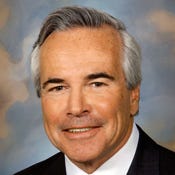
James Turnbull
James Turnbull CIO, University of Utah Hospitals & ClinicsWith a 37-year career in the healthcare industry, most of it in health IT, James Turnbull has whipped his share of electronic record projects into shape. As CIO of Sarasota Memorial Hospital in Florida and again as CIO of Children's Hospital in Denver, he supervised the implementation of electronic health records and computerized physician order entry systems. When he joined University of Utah Hospitals & Clinics in 2008, he recalls, the healthcare system had been deploying Cerner on the inpatient side since 2003, but had run into a stone wall on CPOE.
Turnbull led the team to successfully bring the ordering system live. He displayed the same can-do attitude when it came to integrating Cerner with the Epic system that the University of Utah's primary care clinics had been using since 1999. The IT team used a custom-built interface that lets users pull up information from one system while working in the other one, a project that won the organization a Most Wired award from Hospitals & Health Networks magazine.
But that level of interoperability isn't enough. The University of Utah has begun converting the entire organization to Epic, a move it expects to complete by spring 2014. Turnbull explains that clinicians will be able to use a single integrated system more easily, because they will always have the same view of a patient's chart, no matter where they are or what they're doing.
Turnbull's efforts have earned him recognition as the 2012 John E. Gall Jr. CIO of the Year from the Health Information and Management Systems Society. Turnbull is a former president of HIMSS and former chair of the College of Health Information Management Executives.
Turnbull agrees with those who say that the government should slow down the Meaningful Use incentive program and allow healthcare providers to learn lessons from the progress made to date before moving on. "We're dealing with complex organizations, and the biggest concern is the pace of change," he says. "I don't think the biggest pushback is on the standards. It's more about the pace."
-- Ken Terry
Michael Matthews
CEO, InHealth and MedVirginia
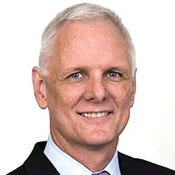
Michael Matthews
Michael Matthews CEO, InHealth and MedVirginiaMichael Matthews wears many hats. He's the CEO of MedVirginia, a Virginia health information exchange, and of InHealth, a clinically integrated network owned by Richmond-area hospitals and physicians. He's also the president and a board member of the eHealth Exchange, a national health information exchange that includes federal agencies and private healthcare organizations.
MedVirginia connects healthcare systems Bon Secours and Centra Health, as well as physician groups and a rehab facility in Richmond. It was the first HIE in the country to go online with federal agencies, including the Social Security Administration, the VA system and the military health system. MedVirginia's nonprofit affiliate holds the contract to build and operate Virginia's statewide HIE, ConnectVirginia.
InHealth also supplies managed care, disease management and operational consulting to members, including Bon Secours' accountable care organization.
Matthews did community health planning in South Carolina and Ohio in the 1970s and 1980s. He supervised strategic planning for Akron City Hospital and Summa Health System from 1981 to 1993. Then he moved to Virginia and started working with a group of healthcare systems that wanted to link their systems together to improve outcomes and begin taking financial risk for care.
Matthews sees three pillars to his overlapping companies: physician engagement, care coordination and health IT. It's complex, but "that's what got me interested in the HIE world, where there are so many disparate parts," Matthews says.
-- Ken Terry
Ed Marx
CIO, Texas Health Resources
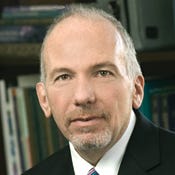
Ed Marx
Ed Marx CIO, Texas Health ResourcesTexas Health Resources earned a rep as a national health IT leader by implementing its electronic health record earlier than most, and that earned IT credibility inside THR.
THR's health IT prowess also helped the organization form an accountable care organization (ACO). In January, the ACO signed agreements with Aetna and Blue Cross Blue Shield of Texas. Both agreements will reward the ACO for providing high-quality care and lowering costs.
CIO and senior VP Ed Marx has a staff of 650 and an annual budget of $100 million to provide IT support to a system that includes 25 hospitals and 5,500 staff physicians, of whom 500 are employed. But Marx, who has been with THR for five years, has a role far beyond the nuts and bolts of technology, sitting on THR's leadership council with about a dozen top company leaders. He helps shape THR's business strategies and sometimes suggests options in areas where the other leaders didn't even know THR had problems, he says.
Marx says the ideal CIO role in a big organization like THR should be 90% strategic and 10% operational. But when there are fires to put out, "I'm going to jump in and help my team," he says. "So my role is probably split more like 70% strategic and 30% operations."
Because of his conviction that health IT must be grounded in clinical knowledge, Marx spends a day each month doing rounds with clinicians in a THR hospital. His senior staff members must do the same. Says Marx: "This makes you realize that you work in healthcare."
-- Ken Terry
Michael Minear
CIO, UC Davis Health System
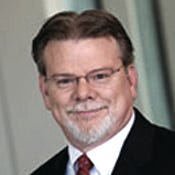
Michael Minear
Michael Minear CIO, UC Davis Health SystemThe University of California Davis Health System in Sacramento, Calif., recently received recognition for having an electronic health record that met the tough HIMSS Analytics Stage 7 criteria. UC Davis CIO Michael Minear says achieving that standard felt good because it was so hard to do.
The entire organization backed the effort, starting with financial support. "We spent easily a couple of million dollars just on bar-code medication administration," Minear says. Physicians, nurses, pharmacists and everyone on the health information management staff all had to make operational changes.
Physician buy-in was a critical part of the effort. Back in 2009, physicians began documenting their care online. Ninety-five percent of the staff now uses computerized physician order entry in the hospital, and nearly all orders are entered electronically. The key force behind adoption is a group of 40 physician champions who meet monthly. "They're highly engaged, and they make things happen," Minear says.
The biggest challenge in achieving Stage 7 was meeting "the scope of expectations," he says. Going truly paperless, for example, doesn't just mean scanning all paper into the system eventually; staff must scan it the same day the paper appears. So IT gave people scanners on carts.
Minear's background is in finance, but he shifted to IT in the early 1980s. He feels particularly lucky to be a CIO at UC Davis because it allows him to be involved in clinical care and also in research and education. "In most academic healthcare systems, those roles are still siloed," he says.
-- Ken Terry
Bert Reese
CIO, Sentara
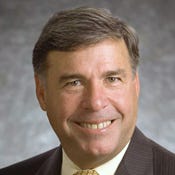
Bert Reese
Bert Reese CIO, SentaraEight of the 10 Sentara Healthcare hospitals across Virginia are at Stage 7 -- the highest level -- of the HIMSS Analytics EMR Adoption Model. "The other two will be over time," promises CIO Bert Reese, as Sentara converts one it acquired in 2009 to its Epic electronic health record and advances analytics at one that opened in 2011.
Less than 2% of U.S. hospitals have reached Stage 7, but the honor is trivial compared to what Reese wants to accomplish: convert Sentara into an accountable care organization that delivers better care, improves population health and reduces costs -- the so-called Triple Aim. Analytics is at the center. "We believe healthcare is a data-driven event," Reese says.
Sentara has a dashboard that draws on products from Epic, Microsoft and SAP. The analytics infrastructure takes feeds from clinical departments, materials management, payroll and sources outside the organization. "It's sort of like a blender," Reese says.
Data is one of three flavors: retrospective, based on historical records; dynamic, such as clinical decision support that updates as new information comes in to provide advice at the bedside; and predictive, the most difficult type to harness but with potentially the greatest impact on Triple Aim goals.
"The trick is to convert data to information and knowledge to action," Reese explains. "You want to speed that information to the point of care."
Sentara's road to becoming an ACO is eased because the company has a health insurance plan, so financial incentives are more aligned with outcomes goals than many of its noninsurance competitors. "We can get to the at-risk [payment] model quicker than most," Reese says. That only happens, however, with ready access to clinical intelligence and the right data to feed the intelligence engine, he says.
-- Neil Versel
Michael O'Rourke
CIO, Catholic Health Initiatives
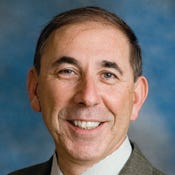
Michael O'Rourke
Michael O'Rourke CIO, Catholic Health InitiativesMichael O'Rourke has a daunting task. As senior VP and CIO of Catholic Health Initiatives, he leads the effort to bring up electronic health records in 76 acute-care hospitals and more than 300 ambulatory care clinics in 19 states. His deadline: complete most of the job by the end of June so that the majority of CHI's facilities and clinics can meet Meaningful Use standards in time to get government EHR incentives for this year.
Here's where things stood when we interviewed O'Rourke earlier this year: With ambulatory care EHRs installed in CHI facilities in Iowa, Kentucky, Nebraska, North Dakota, Minnesota, and Tacoma, Wash., about 70% of CHI clinics had EHRs certified for Meaningful Use. O'Rourke expected the majority of CHI hospitals, which started the process later than clinics, to be online by June.
Like many in health IT, O'Rourke is nervous about the timing of Meaningful Use Stage 2, which begins for hospitals in October. "Much of the industry is in a scramble to get the first stage up for Meaningful Use," he says. "And Stage 1 is fairly straightforward; Stage 2 is a lot more rigorous." He already has teams preparing for Stage 2, while others work on EHR deployment and Stage 1.
While it isn't easy to run an IT department in such a far-flung operation, O'Rourke had plenty of experience working in multihospital systems such as Catholic Healthcare West and Triad Hospitals before joining CHI in 2007. Reporting to him are regional CIOs who supervise the work in each region. CHI ties it all together through an IT steering committee that includes C-suite execs from all divisions.
O'Rourke's challenge is ensuring that the pace of implementation is as fast as possible while making sure clinician adoption doesn't fall behind.
-- Ken Terry
Kara Marx
CIO, Methodist Hospital of Southern California
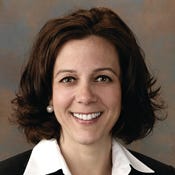
Kara Marx
Kara Marx CIO, Methodist Hospital of Southern CaliforniaMethodist Hospital of Southern California, in the Los Angeles suburb of Arcadia, is steadily working through its many regulatory requirements. But CIO Kara Marx isn't looking just to meet the minimums. "We want full adoption when we roll these things out," says Marx, referring to systems such as bar-coded medication administration. "We just think it's the right thing to do."
The hospital attested to Stage 1 Meaningful Use for Medicaid in 2011 and for Medicare in 2012, and it's looking to reach Stage 2 as soon as the measurement period opens for inpatient care in October. It's moving quickly on Stage 2 to free up resources for ICD-10 in 2014. Getting to Stage 2 of the federal electronic health record incentive program will require some "heavy lifting" at Methodist.
Marx is a registered nurse, a fact she believes helps her talk with clinicians as a peer and not an adversary, and to gain buy-in more quickly than if she had come solely from the IT world. "Having a clinical background allows the conversation to be a lot more fluid," Marx says.
Communication is crucial because IT teams for the 596-bed hospital are managing a menagerie of IT systems. Methodist has used an Eclipsys (now Allscripts) Sunrise clinical system since 2008, and also runs QuadraMed billing software, and a picture archiving and communication system from DR Systems.
"We feel very comfortable. We're not making any major changes," says Marx, who previously worked for EHR vendor Cerner and for First Consulting Group. Still, as Meaningful Use and other healthcare reforms advance, Methodist must be able to share data with organizations that use different vendors. "We have to learn to live in that environment," she says.
Methodist also is learning to live in an era of patient engagement by making its IT more accessible by consumers. Marx sees patient engagement "as a strategy that has many different layers to it." The hospital already has a portal, which addresses a specific requirement in Meaningful Use regulations, as well as a centralized scheduling and preregistration system. It's considering a social media component.
A mobile app also is on the list. The hospital hasn't started on the app yet but is looking to offer it first for the emergency department and outpatient services. "We think that will be a really critical part to patient engagement," she says.
-- Neil Versel
Gretchen Tegethoff
CIO, Athens Regional Health System
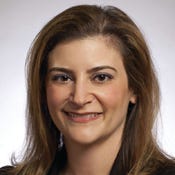
Gretchen Tegethoff
Gretchen Tegethoff CIO, Athens Regional Health SystemAfter not quite 18 months on the job as VP and CIO of Athens Regional Medical Center in Athens, Ga., Gretchen Tegethoff is feeling comfortable in the role. Mostly.
The toughest challenge? "Having to balance organizational needs with federal responsibilities," she says.
It has been a hectic time since Tegethoff came to Athens in February 2012 after six years as CIO of George Washington University Hospital. Athens Regional has begun its 90-day measurement period for its first year of meeting Meaningful Use Stage 1 standards and plans on attesting this spring.
The IT shop also is installing a patient portal to its Allscripts inpatient electronic health record in preparation for Stage 2 and is selecting an ambulatory records system, while also preparing for the switch to ICD-10 coding in October 2014 and adjusting to other realities of healthcare reform.
Tegethoff took a patient approach to understand the job and organization. "After six to eight months, you probably have a good idea of what the job is like," Tegethoff says. "I'm glad I gave myself an extra few months and found clarity on roles and responsibilities."
Another major challenge is finding enough qualified talent.
Athens is a city with a population of about 115,000, and Athens Regional competes for tech pros with hospitals in the Atlanta area, 70 miles away. Tegethoff hopes to connect the medical center to the University of Georgia, also in Athens, possibly to educate students about health IT and tap into the school's work-study program, grooming candidates for possible future employment. "I'm encouraged every time I see a new [training] program out there," Tegethoff says.
-- Neil Versel
Ed Kopetsky
CIO, Lucile Packard Children's Hospital

Ed Kopetsky
Ed Kopetsky CIO, Lucile Packard Children's HospitalLucile Packard Children's Hospital has been around for more than 20 years, but it's facing major change to keep up with the times. The hospital was created as a very high-end inpatient and research hospital -- meant to advance pediatric medical science and manage very severe and complex cases. But healthcare is evolving to put more emphasis on accountable care and the full continuum of treatment before, during and after a hospital visit.
Ed Kopetsky arrived as CIO of the hospital four years ago as this change was gaining momentum. The hospital was addressing the needs of patients once they returned to their communities by partnering with other health systems and building its own physician community network. Kopetsky realized Packard Children's IT would become a problem in this new model, because the systems were geared toward inpatient care.
So the hospital decided about 16 months ago to overhaul the entire IT system. The restructuring includes adding new analytical tools and replacing human resources, supply chain software and billing software. It includes conversion from Cerner to Epic for clinical systems and electronic medical records. That will allow Packard Children's to better exchange patient data with other hospitals in the region, since most are now Epic shops, Kopetsky says.
It adds up to much more than a typical IT project. "It's complementary to and critical to the transformation of the overall business," says Kopetsky. The next step will include telemedicine capabilities so the hospital can monitor very sick children and pick up on early indicators that may signal the need for escalated care. "Getting to the right level of care fastest" is critical to achieve the best possible outcomes and deliver quality care, says Kopetsky.
Kopetsky is no stranger to such megaprojects. Prior to joining Packard Children's in 2009, he was a partner in IBM's services business, and executive VP with the consulting firm Healthlink. He has also served as senior VP and CIO for Centura Health and Sharp HealthCare.
Kopetsky and his team also plan to implement a personal health record system to let parents enter data about the patient as things happen. If families choose to share that data with the hospital, clinicians will have more up-to-the-minute data on each child's condition and needs.
-- Paul Cerrato
Michael Smith
CIO, Lee Memorial Health System
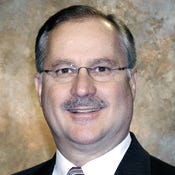
Michael Smith
Michael Smith CIO, Lee Memorial Health SystemAs CIO of Lee Memorial Health System, Michael Smith is in charge of more than just IT. He also oversees health information management, biomedical engineering and diagnostic technology for the public health system in southwest Florida.
Biomedical engineering means Smith oversees the operation of medical devices. "More and more CIOs are involved in the biomedical engineering side these days because everything needs to be connected," Smith says.
There's no shortage of conventional IT work, with an implementation of an Epic Systems electronic health record in multiple stages. "It's been all hands on deck with putting in Epic," Smith says, on and off for six years. Lee Memorial has had an Epic ambulatory EHR since 2007 and has been replacing legacy inpatient systems in phases since 2009. That project slowed as the health system completed two hospital acquisitions.
The organization now has nearly 1,500 beds across four acute-care hospitals and two specialty hospitals, and also a long-term care facility and a network of outpatient clinics. IT brought the new hospitals live with clinical documentation in stages. Smith is leading a "big bang" rollout of computerized physician order entry this month.
Lee Memorial plans to replace its children's hospital in 2016, and other facilities are under renovation. "There is more to do than there is funding or time to do it," Smith says. He also sees a shortage of qualified health IT professionals. "I think the tension is going to get worse."
Prioritizing takes strong communication among senior leaders and operational units. "The good news is, we're efficient," says Smith. "The bad news is, it's a fairly tight margin."
-- Neil Versel
Carol Steltenkamp
CMIO, UK HealthCare
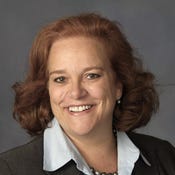
Carol Steltenkamp
Carol Steltenkamp CMIO, UK HealthCareI am not a techie," concedes Dr. Carol Steltenkamp, chief medical information officer of University of Kentucky HealthCare. Yet she has positioned the academic health system as a leader in IT since she arrived in 2006, carrying on a legacy that predates her tenure.
In January 2011, UK HealthCare became the first organization in the U.S. to get a bonus Medicaid check for Meaningful Use. Years earlier, in 2003 and 2004, the health system took the then-daunting step of installing computerized physician order entry at a time when the Leapfrog Group was touting CPOE as one of its four key "safety practices."
"The very first thing we did on the inpatient side was CPOE," Steltenkamp says. CPOE usually is one of the toughest pieces of clinical IT -- the medical staff at Cedars-Sinai Medical Center in Los Angeles rebelled against a poorly implemented system in 2003 -- but UK HealthCare got it done and has been refining it for years.
But the order sets at UK had gotten unwieldy. "We have too dang many," Steltenkamp says. So UK is updating its technology as a beta customer of Elsevier's InOrder cloud-based system for creating and managing order sets. For example, the health system had nine order sets related to stroke care across its main UK Chandler Hospital, the adjacent Kentucky Children's Hospital and the UK Good Samaritan Hospital. It has condensed those to two. A pediatrician who practices part-time, Steltenkamp sees her clinical background as helpful in understanding how to cull order sets and build useful ones backed by proper medical evidence.
As a CMIO, her challenge is to apply data to deliver actionable knowledge at the right point in the workflow to help clinicians make "judicious decisions," she says. Steltenkamp looks at the multitudes of clinical data UK HealthCare has compiled and deems it "untapped."
-- Neil Versel
Rebecca Kaul
President, UPMC Tech Development Center
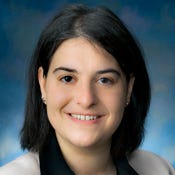
Rebecca Kaul
Rebecca Kaul President, UPMC Tech Development CenterHaving every possible bit of information about a patient, says Rebecca Kaul, "is equal to having nothing." Kaul's point is that health IT only helps the industry if it lets people use all that data to solve problems.
The need for practical health IT was one reason the University of Pittsburgh Medical Center in 2010 created its Technology Development Center, with Kaul as president. The other was the chance for UPMC to cash in when it helped hone a new technology. TDC finds a problem UPMC faces and makes an equity investment in a startup trying to solve it or creates a joint venture with an established vendor. UPMC's edge, Kaul says, is that it can provide insight into the problems vendors can't get on their own.
TDC is investing in three main areas: visualization to help physicians make sense of data; collaboration to help groups involved in care use the same data; and data transformation, such as projects with Nuance and Optum to use natural language to pull insights from verbal notes. Kaul also is looking at decision support systems for potential investments.
-- Chris Murphy
Lawrence Garber
Director for Informatics, Reliant Medical Group
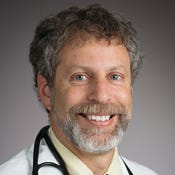
Lawrence Garber
Lawrence Garber Director for Informatics, Reliant Medical GroupMedical school could not have prepared Dr. Lawrence Garber for this.
In 2005, Reliant Medical Group (then known as Fallon Clinic) decided to switch from a homegrown medical record system it had used since 1992 to Epic electronic health records. The company's leadership knew the value of historical data and wanted to keep its records. So Garber personally mapped more than 100,000 terms used in the legacy system to Epic terms. "It took a year off my life," Garber says with a laugh. "But it was absolutely worth it." Reliant transferred more than 100 million records, such as lab tests and medications. Reliant got its modern EHR, but with data as if it had been on Epic for 15 years.
Garber is an internist who spends about a quarter of his time practicing medicine and the rest as director for informatics at Reliant, the 250-physician group where he has worked for 27 years and which is part of the Atrius Health Group of practices.
In retrospect, Garber sees three pillars that were critical to the Epic rollout: value, meaning all stakeholders get something out of moving to the system, since it did take a lot of money and time; usability, which meant spending a lot of time on interfaces and workflows so the EHR helps in the care of patients; and trust, which came from factors such as getting many clinicians involved in the implementation and relying on staff instead of consultants to implement it. Clinicians including Garber spent three weeks at Epic's Wisconsin HQ to become certified, as did in-house IT pros.
Hassle Free
Today Garber is putting a major emphasis on automation and connectivity -- what he calls "hassle free" health information exchange.
For example, there are the interfaces Reliant built with five hospitals, so that when patients are discharged, their follow-up instructions and medications are automatically sent to physicians with an alert. A decision support system looks at new medications and sends an alert three days after discharge, flagging possible tests -- say, a potassium test if the patient was prescribed a diuretic.
In addition, if the patient is 65 or older, the physician's staff gets a message to schedule a follow-up visit, since those visits have proven effective in preventing readmissions. This kind of automation "is the key to health information exchange," Garber says.
Reliant in the coming months will start using the Mass HIway HIE, which will allow interfaces to be built once and used for many area hospitals.
When Garber isn't practicing, he sits near fellow members of a team focused on applications. While big decisions go to a governance committee, many changes and fixes happen based on quick conversations among that small team. Garber hears a lot about analytics, and he doesn't doubt the importance of looking at historical data. But "what's most important is to get the actionable data right to the front lines," he says. At Reliant that means loading claims data into the EHR, since that might show a person got a tetanus shot while on vacation in Florida that otherwise wouldn't hit the record.
-- Chris Murphy
Dan Moriarty
CIO, Atrius Health
Michael Lee
Director of Informatics, Atrius Health
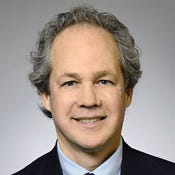
Dan Moriarty
Dan Moriarty CIO, Atrius HealthIn the years ahead, more healthcare providers will get paid based on whether they keep people healthy. Atrius Health is "already very deeply into the new world," says CIO Dan Moriarty, with more than half of its revenue coming from this risk-based model.
Atrius Health is Massachusetts' largest independent physician group, and it's one of 32 pioneer accountable care organizations, working with the Centers for Medicare & Medicaid Services to test the ACO model. As an ACO, Atrius Health has financial risk because "if we have low cost and low quality, or high cost and high quality, we will end up losing money on the deal," says Dr. Michael Lee, Atrius Health's director of informatics.
Health IT plays a strategic role in helping Atrius Health meet its ACO goals. One important way is improving information sharing with the many hospitals Atrius Health works with.
As CIO, Moriarty has led a standardization effort that now has all 50 of Atrius Health's locations on the same platforms, including Epic electronic health records and common practice management, imaging and radiology systems. Standardization makes data sharing easier within Atrius Health and with the 35 hospitals to which Atrius Health has 200 or more admissions in a year.
If an Atrius Health patient goes to a hospital, physicians can use a Web portal to look the person up; they can click one button and data from the hospital stay will be added to the Epic record. Atrius Health created the first such link with Beth Israel Deaconess Medical Center and now has them with 16 providers, about half of which let the hospital bring data in from physician records as well. Five more are in the works.

Michael Lee
Michael Lee Director of Informatics, Atrius HealthThe next leap is automating data exchange without a patient lookup; the first attempt went live this year. Using the state's new Mass HIway health information exchange, a patient arriving at the emergency room automatically triggers a message to the primary care doctor's inbox in the Epic EHR. That inbox is the place "every one of our doctors go every day to do their jobs," Moriarty says, so it's part of their routine. Using the HIE protocol standards means Atrius Health can use the same Epic integration to the HIE with other state hospitals.
In his informatics role, Lee focuses on giving clinicians data to make better decisions at the point of care. Lee, a pediatrician, is one of several clinicians at Atrius Health who practices medicine and helps shape technology strategy. He helps set the priorities and designs for clinical support systems, and Moriarty's IT teams does the technical work, project management and training.
Measuring outcomes takes a lot of work documenting what Atrius Health does, Lee says, and some of that data entry falls on already-busy doctors. Lee acknowledges that tension as one of the most difficult elements of health IT. Also difficult are regulatory requirements, such as moving to ICD-10 and meeting Meaningful Use standards, which dominate today's priority list. But Lee sees healthcare pros accepting the digital future: "Though people complain about electronic records, no one wants to go back to paper."
-- Chris Murphy
About the Author
You May Also Like






